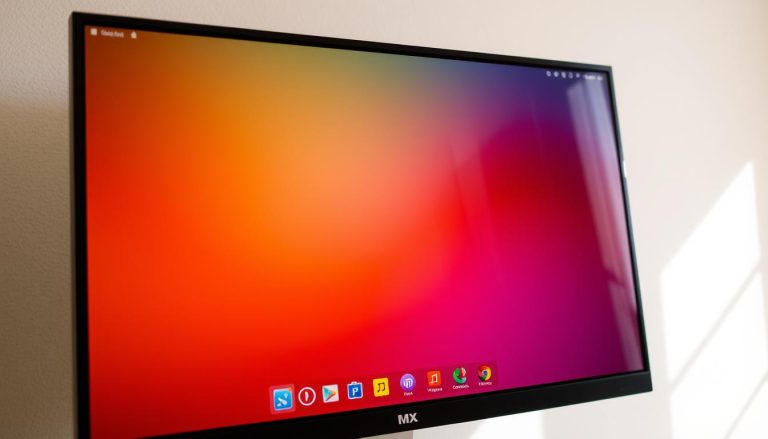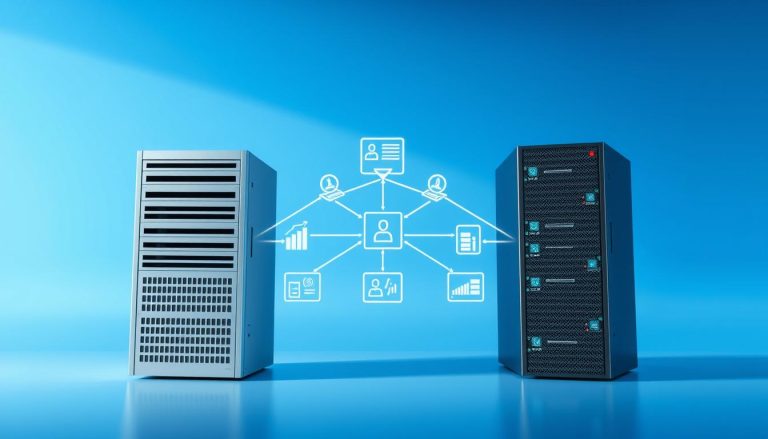Have you ever wondered where the next big features for a major enterprise operating system come to life before they reach production? This question lies at the heart of a powerful, continuously delivered distribution designed for innovation.
We are talking about a unique platform that serves as the upstream development branch for Red Hat Enterprise Linux. Instead of being a traditional rebuild, this distribution provides a rolling preview of what’s next. It allows developers and system administrators to see and test future enhancements.
The development process is transparent. Code moves through this continuous delivery stream before being solidified into a stable Red Hat Enterprise Linux release. This model creates a vital bridge between cutting-edge development and enterprise-grade stability.
This guide will explore the core functionality of this platform. We will clarify its primary use cases and address common misconceptions about its stability for professional environments.
Key Takeaways
- CentOS Stream is a continuously delivered Linux distribution, not a traditional static release.
- It functions as the upstream development platform for Red Hat Enterprise Linux (RHEL).
- The platform offers a rolling preview of features destined for future RHEL versions.
- It enables community participation in the development process of a major enterprise OS.
- Primary use cases include development environments and testing future RHEL features.
- It is designed to be a stable platform for specific professional use cases.
Introduction to CentOS Stream and Its Evolution
December 2020 marked a pivotal moment for enterprise Linux users with the announcement of CentOS’s new direction. The project shifted focus from traditional CentOS Linux to the rolling-release CentOS Stream model. This change addressed fundamental limitations in the previous approach.
Background from CentOS Linux to CentOS Stream
Originally, CentOS Linux served as a downstream rebuild of Red Hat Enterprise Linux. It provided a free alternative but followed RHEL releases with significant delays. These 4-6 week gaps between minor release updates left systems vulnerable to security threats.
The project announced end-of-life dates for previous versions. CentOS Linux 8 reached its end life on December 31, 2021. CentOS Linux 7 followed on June 30, 2024. Staying on unsupported versions exposes organizations to unpatched vulnerabilities.
The Need for a Rolling-Release and Continuous Delivery Model
The new model eliminates dangerous gaps in security coverage. CentOS Stream provides continuous updates rather than point-in-time rebuilds. This ensures timely patching and feature integration.
This platform enables real-time contribution to Red Hat Enterprise Linux development. Partners and community members can now influence the next version as it’s being built. The relationship has transformed from passive consumption to active participation.
The first iteration, CentOS Stream 8, launched on September 24, 2019. It offered a migration path from CentOS Linux 8, providing a smooth transition for existing users. Current support timelines extend through May 2027 for Stream 9.
Foundational Concepts Behind CentOS Stream
Version control practices form the backbone of reliable software delivery in enterprise environments. We’ll explore the core management strategies that enable Red Hat to maintain multiple versions simultaneously.
Understanding the Role of Git Branches in RHEL Development
Red Hat employs strategic branching to organize its development workflow. The platform builds from stable release branches rather than experimental main branches.
This approach ensures tested code flows through the system. Each component maintains separate branches for major versions.
Feature branches allow developers to work on specific changes independently. Once tested, these modifications merge into stable branches.
Semantic Versioning and Release Management
Semantic versioning provides clear meaning behind version numbers. MAJOR.MINOR.PATCH numbering communicates compatibility changes effectively.
MAJOR versions indicate breaking changes, while MINOR versions add features. PATCH versions contain only bug fixes for the software.
This taxonomy helps users assess risk when adopting new releases. Understanding this source code strategy clarifies the platform’s stability.
Positioning CentOS Stream in the Red Hat Ecosystem
The Red Hat development pipeline operates as a carefully orchestrated three-stage process. This structure balances cutting-edge features with production reliability across different platforms.
Each component serves distinct purposes while working together seamlessly. Understanding this hierarchy helps organizations select the right platform for their specific needs.
Relationship Between Fedora, CentOS Stream, and RHEL
The Fedora Project acts as the innovation laboratory where major operating system advancements debut. Here, new features undergo community testing before enterprise consideration.
This rolling-release platform occupies the middle position in the red hat ecosystem. It receives stabilized innovations from Fedora and serves as the preview for upcoming Red Hat Enterprise Linux releases.
The flow moves from experimental to enterprise-ready. Code matures through each stage, with this continuous delivery platform providing crucial stabilization.
This positioning creates shorter feedback loops between developers and the enterprise linux team. Partners can influence development proactively rather than reacting to finalized releases.
The three-tier approach ensures balanced progression from innovation to production stability. Each platform serves its part in delivering reliable red hat enterprise solutions.
Key Functionalities and Use Cases for IT Professionals
Organizations can transform their development processes through early access to enterprise innovations. This platform serves as a strategic tool for technical teams seeking to stay ahead of upcoming changes.
Community Contributions and Transparency Benefits
The open development model empowers community members to propose changes directly. Developers can submit bug fixes or enhancements for evaluation by Red Hat engineers.
Accepted contributions undergo thorough testing before integration. This collaborative approach strengthens the overall quality of enterprise solutions. The entire community benefits from transparent development processes.
Hardware vendors and software partners gain early testing capabilities. They can validate product compatibility with future releases before public availability.
Early Access to Source Code Innovations
Technical teams receive preview access to the same source code used by Red Hat developers. This provides unprecedented visibility into upcoming features and improvements.
Development environments can test workloads against future enterprise releases. This proactive approach reduces deployment risks and compatibility issues. Teams can prepare applications and infrastructure well in advance.
The continuous delivery model ensures timely access to innovations. This strategic advantage helps organizations maintain competitive edge in their technical operations.
CentOS Stream vs Traditional CentOS and Other Distributions
Understanding the architectural differences between these platforms reveals their distinct purposes. The traditional model followed a downstream approach, rebuilding completed Red Hat Enterprise Linux releases. This created significant delays in security updates and feature availability.
The new continuous delivery model operates upstream, allowing real-time contribution to enterprise development. This fundamental shift transforms users from passive consumers to active participants in the ecosystem.
Comparison with CentOS Linux and Fedora
We must clarify a common misconception about traditional compatibility. The “bug-for-bug compatible” claim was always an aspirational goal rather than achieved reality. Minor differences consistently existed between the rebuilds and their enterprise counterparts.
The most critical improvement addresses security coverage gaps. Traditional rebuilds left systems unprotected for 4-6 weeks during minor release transitions. This rolling platform eliminates these dangerous periods through continuous patching.
Compared to Fedora’s rapid innovation cycle, this distribution receives stabilized features rather than experimental changes. Both use RPM-based package management but serve different stability requirements. The architectural differences create distinct operational models for various use cases.
Migration requires adjusting from predictable point releases to continuous updates. This platform offers superior security coverage without unsupported gap periods. The measured update frequency balances innovation with production reliability.
Analyzing the Rolling-Release Model and Update Mechanisms
Unlike traditional point releases, this distribution employs a unique rolling preview model. It continuously integrates improvements destined for the next Red Hat Enterprise Linux minor release. This approach ensures a steady flow of tested enhancements.
Kernel Updates and Continuous Feature Integration
Kernel improvements arrive more frequently in this platform. The current version utilizes the 5.14 kernel with significant security and performance benefits. These updates undergo thorough testing before integration.
Hardware compatibility and performance optimizations reach users earlier. The continuous delivery model prevents artificial delays in critical updates. This benefits the entire operating system ecosystem.
Understanding Update Frequencies and Stability Implications
Package updates follow a carefully managed schedule. Each change completes quality assurance before merging into the stable branch. This ensures enterprise-ready stability throughout the development cycle.
The platform eliminates waiting periods for security patches and bug fixes. Traditional release schedules often delay critical improvements. This model represents a significant advancement for most use cases.
All modifications in the release branch undergo comprehensive vetting. The code quality matches enterprise standards from the moment of integration. This provides confidence in the platform’s reliability.
Migration Strategies and Upgrade Paths
Migration planning requires careful consideration of available tools and pathways. Organizations must evaluate their specific needs before selecting the appropriate transition strategy.
We’ll explore the practical steps for moving between platforms. This includes both automated tools and manual processes.
Using Tools Like Convert2RHEL for System Conversion
The Convert2RHEL tool provides a direct path from CentOS Linux to Red Hat Enterprise Linux. This utility simplifies the conversion process for organizations seeking production-grade support.
This tool works seamlessly with CentOS Linux systems but has an important limitation. It does not support conversion from the rolling-release platform, requiring fresh installation for that transition.
The utility also supports migration from Oracle Linux to Red Hat Enterprise Linux 8. This flexibility demonstrates its value across different source distributions.
Steps for Migrating from CentOS Linux to CentOS Stream
Moving from traditional CentOS Linux to the continuous delivery model follows a straightforward process. The CentOS Project designed this migration to be accessible for users needing continued updates.
Organizations must choose between migrating to the rolling platform for free access or moving to Red Hat Enterprise Linux for commercial support. This decision depends on workload criticality and organizational requirements.
Planning migration timelines around end-of-life dates is crucial for security. Running unsupported systems exposes organizations to unpatched vulnerabilities.
Red Hat Consulting services can accelerate complex migrations. They provide expertise in workload assessment and application compatibility testing.
Exploring “What is CentOS Stream” in Depth
Modern software development thrives on transparency and collaborative input, which is precisely what this platform delivers. We’ll examine how its architecture transforms community engagement with enterprise Linux evolution.
Detailed Examination of Key Features and Development Pipeline
The development pipeline follows a clear maturation path. Features begin in Fedora as innovative concepts before stabilizing in this continuous delivery environment. They then progress to Red Hat Enterprise Linux as production-ready capabilities.
This platform architecture enables continuous integration of validated changes. It creates a living preview of the next RHEL minor release that updates dynamically. The system ensures tested code flows smoothly toward enterprise readiness.
Open git repositories provide unprecedented transparency for developers. They can track exactly what changes are being prepared for future versions. This visibility allows proactive preparation rather than reactive adaptation.
Enhanced containerization support demonstrates the platform’s modern focus. Native integration with Podman, Buildah, and Skopeo addresses cloud-native application development needs. These tools receive early updates and improvements.
The distribution tracks “just ahead” of RHEL, containing approved but unpublished changes. This positioning gives developers direct influence over the enterprise Linux development stream. They can submit patches and propose features during active development cycles.
Understanding this platform as a development preview helps organizations make appropriate deployment decisions. It serves as a strategic tool for testing and preparation rather than a production alternative.
Strategic Considerations for Production Versus Development Use
Choosing the right platform for enterprise workloads requires careful evaluation of support models and stability requirements. We need to distinguish between environments where innovation matters most versus those demanding maximum reliability.
This rolling-release platform excels in development and testing scenarios. It provides invaluable preview capabilities for teams preparing for future enterprise Linux releases.
Assessing Support and Stability for Enterprise Environments
The community-driven support model works well for technical teams comfortable with self-service troubleshooting. However, mission-critical systems often require commercial service level agreements.
Red Hat Enterprise Linux offers dedicated technical assistance for production environments. This becomes crucial for business applications requiring guaranteed response times.
Security updates arrive quickly on both platforms. The continuous delivery model actually provides patches faster than traditional rebuilds. Yet RHEL includes additional certifications for regulated industries.
Hardware and software partners rely on this development platform for compatibility testing. They ensure their products work seamlessly with upcoming enterprise releases. This benefits the entire ecosystem.
Organizations should evaluate their risk tolerance and compliance needs. The rolling-release approach introduces more frequent changes than some production systems can accommodate.
For development labs and CI/CD pipelines, this platform delivers exceptional value. Production workloads often benefit from RHEL’s predictable release cycle and commercial support.
Conclusion
In today’s rapidly changing technology landscape, organizations need platforms that bridge innovation with enterprise stability. This continuous delivery model represents a fundamental evolution in how enterprise Linux development occurs.
The platform occupies a unique position as an upstream development environment. It provides preview access to upcoming Red Hat Enterprise Linux features while enabling direct community contribution.
The continuous delivery approach eliminates dangerous gap periods that left traditional systems temporarily unpatched. This represents a significant security improvement over point-release distributions.
For development and testing environments, this platform delivers exceptional value. Red Hat Enterprise Linux remains the recommended choice for production workloads requiring commercial support and stability guarantees.
The transparency benefits extend across the entire open source ecosystem. Hardware vendors, software developers, and cloud platform providers all gain from this collaborative model.
Organizations have multiple viable paths depending on their specific requirements. Understanding the platform’s actual functionality enables informed decisions that align with technical needs and business objectives.
FAQ
How does CentOS Stream differ from the traditional CentOS Linux distribution?
Is CentOS Stream suitable for production environments?
What is the relationship between Fedora, CentOS Stream, and Red Hat Enterprise Linux?
How can I migrate my system from CentOS Linux to CentOS Stream?
Does CentOS Stream receive the same security updates as Red Hat Enterprise Linux?
What are the main benefits for developers using CentOS Stream?
Cathy is a senior blogger and editor in chief at text-center.com.



